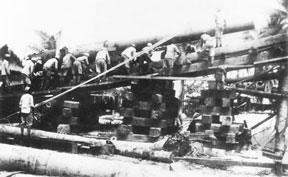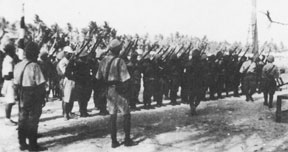| Special Naval
Landing Forces
By Mike Bennighof, Ph.D.
August 2022
 While the Japanese Army provided the overwhelming
majority of Japan’s land forces during
World War II, the Japanese Navy’s ground
troops saw significant action as well, especially
against the United States. These troops appear
in our Panzer Grenadier: Saipan 1944 game alongside
conventional Army troops. While the Japanese Army provided the overwhelming
majority of Japan’s land forces during
World War II, the Japanese Navy’s ground
troops saw significant action as well, especially
against the United States. These troops appear
in our Panzer Grenadier: Saipan 1944 game alongside
conventional Army troops.
Rivalry between Imperial Japan’s Army
and Navy had roots deep in the island empire’s
feudal structure. After the Mieji Restoration
of 1868, clans of different factions sent
their sons to become officers in one service
or the other, but did not intermix them. This
was far more than interservice rivalry on
the American model; the Army and Navy reflected
a millennium of distrust and dislike. No amount
of "jointness" would heal this breach.
The Army would not provide soldiers for what
it saw as naval operations, while the Navy
did not want them aboard its ships anyway.
During the First World War Japanese ships
detailed groups of sailors as landing parties
for shore actions. Afterwards, the Navy formed
its own infantry force, known as Rikusentai
(“naval landing parties”), or
Special Naval Landing Forces. Each force was
brigade-strength, about 2,000 men. These sea
soldiers saw their first action in 1932, during
the “Shanghai Incident.”
Brigades proved unwieldy in action, and
in 1939 the Navy began re-organizing them
into battalion-sized forces. Each Special
Naval Landing Force, named for the naval base
where it was organized, had two rifle companies
and one or two heavy weapons companies. Of
the 12 such forces organized before Pearl
Harbor, several of them had oversized companies,
with six rather than the four platoons common
to an Army rifle company. The Navy also fielded
base defense units, though these had a lower
standard of training and personnel selection.

SNLF troops practice with the Nambu light
machine gun. |
Naval troops wore uniforms of a similar cut
to those of the Army, but olive drab rather
than the Army’s khaki and with black
rather than brown boots. They carried the
same weapons as Army soldiers, 6.5mm Arisaka
rifles and 6.5mm and 7.7mm Nambu machine guns.
The heavy weapons companies included machine
guns and the typical 75mm howitzers and 70mm
mountain guns used by the Army, but also 76.2mm
naval guns on artillery carriages. Weapons
companies also were often oversized, with
several rifle platoons as well as the “heavy”
components.
Two of the Forces, 1st and 3rd Yokosuka, had
jump training for use as paratroopers. They
along with the other Forces practiced opposed
amphibious landings as well as standard infantry
training. Standards appear to have been high;
U.S. Army conclusions that these units were
not particularly good seem to have been based
on encounters with the lower-quality troops
found in the base defense units. The U.S.
Marine Corps had a much different assessment.
“Naval units of this type are usually
more highly trained,” read the 6th Marine
Division’s intelligence report before
the landing on Tarawa in August 1943, “and
have a greater tenacity and fighting spirit
than the average Japanese Army unit.”
Tarawa veterans found the reports highly accurate.
“They were pretty tough, and they were
big, six-foot, the biggest Japs that I ever
saw," recalled Maj. Lawrence C. Hays.
“Their equipment was excellent and there
was plenty of surplus found, including large
amounts of ammo.”
Japan had no equivalent of the U.S. Marine
Corps — each SNLF, though named for
a naval base, reported to a fleet headquarters.
Some ad hoc organizations appeared with two
or three SNLF units commanded by a rear admiral,
but no marine divisions ever existed and no
formal units larger than the battalion-sized
SNLF. In another difference from the American
marines, SNLF soldiers used navy ranks and
insignia.

SNLF anti-tank gun. 7th Sasebo SNLF troops
help mount an 8-inch Vickers naval gun
on Betio, early 1943. |
The war with the United States, Britain and
the Netherlands was the Navy’s war (the
Army’s war being the conflict with China
begun in 1937), and the SNLF troops were in
the forefront of Japan’s advance across
the Pacific. They spearheaded the landings
in the Philippines and the Dutch East Indies,
with great success.
The 1st and 2nd Sasebo and 2nd Yokosuka SNLF’s
attacked islands off Luzon to seize airfield
sites, while 1st Kure SNLF formed the first
wave of the Army’s main landing at Legaspi.
The 1st and 2nd Kure, 1st and 2nd Sasebo,
and 1st, 2nd, and 3rd Yokosuka SNLF's all
undertook repeated assault landings in the
Dutch East Indies, with 2nd Kure having the
primary Japanese assault role in the bloody
battle at Tarakan.
A company from the 1st Maizuru SNLF undertook
the first assault on Wake Island, bloodily
repulsed by the U.S. Marine garrison there.
The 2nd Maizuru SNLF undertook the second,
successful attack that captured the island.
Japan’s first airborne landing came
at Menado on Celebes in the Dutch East Indies,
when 1st Yokosuka paratroopers jumped and
linked up with 1st Sasebo that had landed
over the beach. On Sumatra, 3rd Yokosuka undertook
an opposed parachute landing to link up with
the combined Sasebo SNLF’s at Kaepong,
and suffered very heavy casualties. The two
airborne units had only formed in September
1941, and undertook their first training jump
in November. The lack of experience showed,
and only grew worse in coming years as the
Navy quickly organized more SNLF units. The
new units showed markedly less combat ability
than the tough pre-war troops. On Tulagi,
U.S. Marines encountered the 3rd Kure SNLF,
one of the new units. The Kure troops fought
fanatically hard, but on Guadalcanal the 5th
Yokosuka SNLF put up much less determined
resistance and the brunt of the fighting there
would be borne by Army reinforcements.

SNLF troops on parade. |
For the remainder of the war, the SNLF units
fought defensive engagements with just as
much fanatical determination as their Army
counterparts. One of the bloodiest island
battles of the war, the American assault on
Tarawa, was waged by the 7th Sasebo SNLF with
the 3rd Base Defense Unit. The two SNLF airborne
units died to a man on Saipan, fighting as
conventional infantry. But while the Navy’s
army fought at least as hard as the actual
Army, its troops showed the same twisted concept
of honor as their khaki comrades. SNLF and
naval base defense troops massacred tens of
thousands of Filipino civilians before and
during the battle for Manila in 1945, in one
of the worst war crimes of World War II.
You can order Saipan 1944 right here.
You can order Marianas 1944 right here.
Sign up for our newsletter right here. Your info will never be sold or transferred; we'll just use it to update you on new games and new offers.
Mike Bennighof is president of Avalanche Press and holds a doctorate in history from Emory University. A Fulbright Scholar and NASA Journalist in Space finalist, he has published an unknowable number of books, games and articles on historical subjects.
He lives in Birmingham, Alabama with his wife, three children and his new puppy. He will never forget his dog, Leopold.
Want to keep Daily Content free of third-party ads? You can send us some love (and cash) through this link right here.
|
